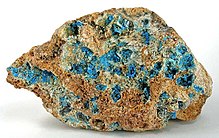
Analcime (; from Ancient Greek ἀνάλκιμος (análkimos) 'not strong') or analcite is a white, gray, or colorless tectosilicate mineral. Analcime consists of hydrated sodium aluminium silicate in cubic crystalline form. Its chemical formula is NaAlSi2O6 · H2O. Minor amounts of potassium and calcium substitute for sodium. A silver-bearing synthetic variety also exists (Ag-analcite). Analcime is usually classified as a zeolite mineral, but structurally and chemically it is more similar to the feldspathoids. Analcime is not classified as an isometric crystal, as although the crystal structure appears to be isometric, it is usually off only by a fraction of an angle. However, there are truly isometric samples of the mineral, which makes its classification even more difficult. Due to the differences between the samples being too slight, there's no merit from having multiple species names, so as a result analcime is a common example for minerals occurring in multiple crystal systems and space groups. It was first described by French geologist Déodat de Dolomieu, who called it zéolithe dure, meaning hard zeolite. It was found in lava in Cyclops, Italy. The mineral is IMA approved, and had been grandfathered, meaning the name analcime is believed to refer to a valid species til this day.

In geology and mineralogy, a mineral or mineral species is, broadly speaking, a solid substance with a fairly well-defined chemical composition and a specific crystal structure that occurs naturally in pure form.
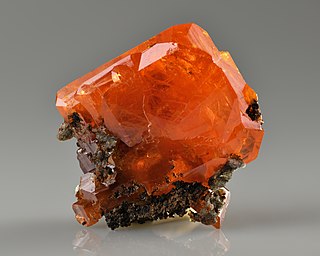
Wulfenite is a lead molybdate mineral with the formula PbMoO4. It often occurs as thin tabular crystals with a bright orange-red to yellow-orange color, sometimes brown, although the color can be highly variable. In its yellow form it is sometimes called "yellow lead ore".
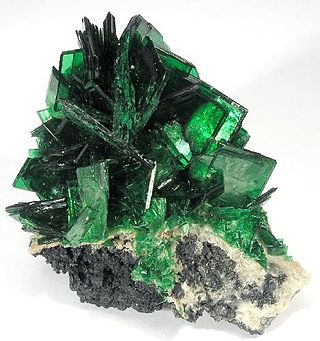
Torbernite, also known as chalcolite, is a relatively common mineral with the chemical formula Cu[(UO2)(PO4)]2(H2O)12. It is a radioactive, hydrated green copper uranyl phosphate, found in granites and other uranium-bearing deposits as a secondary mineral. The chemical formula of torbernite is similar to that of autunite in which a Cu2+ cation replaces a Ca2+ cation. Torbernite tends to dehydrate to metatorbernite with the sum formula Cu[(UO2)(PO4)]2(H2O)8.

Nickel–Strunz classification is a scheme for categorizing minerals based upon their chemical composition, introduced by German mineralogist Karl Hugo Strunz in his Mineralogische Tabellen (1941). The 4th and the 5th edition was also edited by Christel Tennyson (1966). It was followed by A.S. Povarennykh with a modified classification.
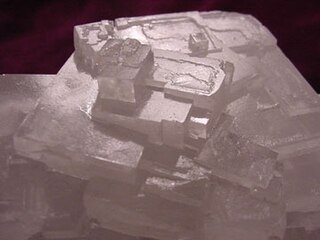
Halide minerals are those minerals with a dominant halide anion. Complex halide minerals may also have polyatomic anions.

Coloradoite, also known as mercury telluride (HgTe), is a rare telluride ore associated with metallic deposit. Gold usually occurs within tellurides, such as coloradoite, as a high-finess native metal.

Mendipite is a rare mineral that was named for the locality where it is found, the Mendip Hills in Somerset, England. It is an oxyhalide of lead with formula Pb3Cl2O2.
Pinalite is a rare lead tungstate–chloride mineral with formula: Pb3WO5Cl2.

Matlockite is a rare lead halide mineral, named after the town of Matlock in Derbyshire, England, where it was first discovered in a nearby mine. Matlockite gives its name to the matlockite group which consists of rare minerals of a similar structure.

Laurionite is a lead halide mineral. It forms colorless to white crystals in the orthorhombic crystal system and is dimorphous with paralaurionite, both members of the matlockite group.
In chemistry, molecular oxohalides (oxyhalides) are a group of chemical compounds in which both oxygen and halogen atoms are attached to another chemical element A in a single molecule. They have the general formula AOmXn, where X is a halogen. Known oxohalides have fluorine (F), chlorine (Cl), bromine (Br), and/or iodine (I) in their molecules. The element A may be a main group element, a transition element, a rare earth element or an actinide. The term oxohalide, or oxyhalide, may also refer to minerals and other crystalline substances with the same overall chemical formula, but having an ionic structure.
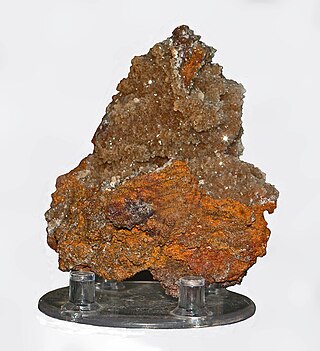
Tarbuttite is a rare phosphate mineral with formula Zn2(PO4)(OH). It was discovered in 1907 in what is now Zambia and named for Percy Coventry Tarbutt.

Diaboleite is a blue-colored mineral with formula Pb2CuCl2(OH)4. It was discovered in England in 1923 and named diaboleite, from the Greek word διά and boleite, meaning "distinct from boleite". The mineral has since been found in a number of countries.

Paramelaconite is a rare, black-colored copper(I,II) oxide mineral with formula CuI
2CuII
2O3 (or Cu4O3). It was discovered in the Copper Queen Mine in Bisbee, Arizona, about 1890. It was described in 1892 and more fully in 1941. Its name is derived from the Greek word for "near" and the similar mineral melaconite, now known as tenorite.

Ganophyllite is a phyllosilicate mineral. It was named by Axel Hamberg in 1890 from the Greek words for leaf (φύλλον) and luster (γανωμα); the latter one was chosen due to the lustrous cleavages. The mineral was approved by the IMA in 1959, and it is a grandfathered mineral, meaning its name is still believed to refer to an existing species until this day. Tamaite is the calcium analogue, while eggletonite is the natrium analogue of said mineral.

Szenicsite is a copper hydroxy molybdate mineral, named after husband and wife Terry and Marissa Szenics, American mineral collectors who found the first specimens. When it was first discovered in Atacama, Chile, it was thought to be lindgrenite. The occurrence appeared in an isolated area, which was about one cubic meter in size. The mineral occurred in cavities of copper bearing powellite and matrix rich molybdenite. These cavities were filled with a material resembling clay. Outside of the zone the szenicsite crystals grew, copper levels seemed to decrease, and the mineralization changed to lindgrenite. Moving further from the zone, the minerals growing seemed to be lacking copper, and consisted of powellite blebs in the ore. Szenicsite was approved by the IMA in 1993.

Olmiite is a rare calcium-manganese silicate that was named after an Italian mineralogist called Filippo Olmi. It was approved by the IMA in 2006, being first published in 2007, which makes it a relatively newly discovered mineral. Around 2001, a large amount of specimens believed to be poldervaartite was discovered at the N'Chwaning II mine, which is near the Wessels mine, where the latter was discovered. Only later were the researchers able to determine through their investigations that the two minerals are different, as they are visually indistinguishable. Until Renato Pagano acquired and examined the specimens, seemingly no specific investigation was carried out. Olmiite has been misidentified not only once, but twice. The cream-colored specimens were at first thought to be baryte by the mine geologist.
Uramphite is a rarely-found phosphate mineral in the "phosphate, arsenate and vanadate" mineral class with chemical composition (NH4)2[UO2PO4]2·6H2O from which it is seen to be a hydrated ammonium uranyl phosphate.
